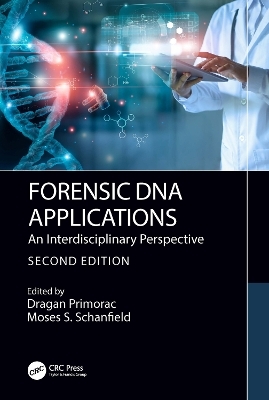
Forensic DNA Applications
CRC Press (Verlag)
978-1-032-39202-8 (ISBN)
Forensic DNA Applications: An Interdisciplinary Perspective, Second Edition is fully updated to outline the latest advances in forensic DNA testing techniques and applications. It continues to fill the need for a reference book for people working in the field of forensic molecular biology testing and research as well as individuals investigating and adjudicating cases involving DNA evidence, whether they be civil or criminal cases.
DNA techniques have greatly impacted obvious traditional forensic areas, but such advances have also positively affected myriad new areas of research and inquiry. It is possible today to think about solving forensic problems that were simply unheard of even a few years ago. As such, the book pulls all relevant research and applied science together into a detailed and comprehensive collection.
Part I begins with the history and development of DNA typing and profiling for criminal and civil purposes. It discusses the statistical interpretation of results with case examples, mitochondrial DNA testing, Y single nucleotide polymorphisms (SNPs) and short tandem repeats (STRs), and X SNP and STR testing. It also explores low copy number DNA typing, mixtures, and quality assurance and control. Part II moves on to cover the various uses and applications of analyzing collected physical evidence, victim identification in mass disasters, analyzing animal DNA, forensic botany, and other unique applications. Part III is dedicated to the latest advances and developments in human molecular biology and Part IV looks at policies and laws and ethics governing DNA evidence, and its utilization in various cases and the courts.
Forensic DNA Applications, Second Edition covers cutting-edge research and advancements in the field and is the most up-to-date reference available. Edited and contributed to by the world's foremost leaders in the field, it is a must-have reference for established professionals, and an essential resource to legal professionals—lawyers and judges dealing with civil and criminal cases involving DNA technology—as well as students entering the fields of genetics and forensic DNA analysis.
Dragan Primorac, M.D., Ph.D., is a pediatrician, forensic expert, and geneticist. Currently, he serves as an adjunct professor at Eberly College of Science, The Pennsylvania State University, and the Henry C. Lee College of Criminal Justice and Forensic Sciences, the University of New Haven in the United States, and at medical schools at universities in Split, Osijek, and Rijeka in Croatia. He is also a professor at the Faculty of Dental Medicine and Health, Osijek, Croatia, Medical School REGIOMED, Coburg, Germany, and professor emeritus at The National Forensic Sciences, University Gandhinagar, Gujarat, India. Moses S. Schanfield, Ph.D. held undergraduate and master's degrees in anthropology and a Ph.D. degree in human genetics. A professor of forensic science and anthropology at George Washington University, Professor Schanfield made widespread contributions to the field and, sadly, passed away in January 2021.
Part I: General Background and Methodological Concepts 1. Basic Genetics and Human Genetic Variation 2. Forensic DNA Analysis and Statistics 3. Forensic Aspects of mtDNA Analysis 4. Y-Chromosome in Forensic Science 5. Forensic Application of X-Chromosome STRs 6. Increasing the Efficiency of Typing Challenged Forensic Biological Samples 7. Mixtures and Probabilistic Genotyping 8. Rapid DNA Part II - Uses and Applications 9. Collection and Preservation of Physical Evidence 10. Mass Disaster Victim Identification by DNA 11. Bioterrorism and Microbial Forensics 12. Forensic Animal DNA Analysis 13. Application of DNA-Based Methods in Forensic Entomology 14. Forensic Botany: Plants as Evidence in Criminal Cases and as Agents of Bioterrorism Part III – Recent Developments and Future Directions in Human Forensic Molecular Biology 15. Forensic Body Fluid and Tissue Identification 16. Evolving Technologies in Forensic DNA Analysis 17. Prediction of Physical Characteristics, Such as Eye, Hair, and Skin Color Based Solely on DNA 18. Molecular Autopsy 19. Genetic Genealogy in the Genomic Era Part IV: Law, Ethics, and Policy 20. DNA as Evidence in the Courtroom 21. Some Ethical Issues on Forensic Genetics 22. DNA in Immigration and Human Trafficking 23. DNA Databases
| Erscheinungsdatum | 27.03.2023 |
|---|---|
| Zusatzinfo | 56 Tables, black and white; 43 Line drawings, color; 4 Line drawings, black and white; 40 Halftones, color; 83 Illustrations, color; 4 Illustrations, black and white |
| Verlagsort | London |
| Sprache | englisch |
| Maße | 178 x 254 mm |
| Gewicht | 1180 g |
| Themenwelt | Medizin / Pharmazie ► Gesundheitswesen |
| Naturwissenschaften ► Biologie ► Genetik / Molekularbiologie | |
| Recht / Steuern ► Strafrecht ► Kriminologie | |
| ISBN-10 | 1-032-39202-9 / 1032392029 |
| ISBN-13 | 978-1-032-39202-8 / 9781032392028 |
| Zustand | Neuware |
| Informationen gemäß Produktsicherheitsverordnung (GPSR) | |
| Haben Sie eine Frage zum Produkt? |
aus dem Bereich


